Yujie Yang
Bridging Performance Gaps for Foundation Models: A Post-Training Strategy for ECGFounder
Sep 16, 2025Abstract:ECG foundation models are increasingly popular due to their adaptability across various tasks. However, their clinical applicability is often limited by performance gaps compared to task-specific models, even after pre-training on large ECG datasets and fine-tuning on target data. This limitation is likely due to the lack of an effective post-training strategy. In this paper, we propose a simple yet effective post-training approach to enhance ECGFounder, a state-of-the-art ECG foundation model pre-trained on over 7 million ECG recordings. Experiments on the PTB-XL benchmark show that our approach improves the baseline fine-tuning strategy by 1.2%-3.3% in macro AUROC and 5.3%-20.9% in macro AUPRC. Additionally, our method outperforms several recent state-of-the-art approaches, including task-specific and advanced architectures. Further evaluation reveals that our method is more stable and sample-efficient compared to the baseline, achieving a 9.1% improvement in macro AUROC and a 34.9% improvement in macro AUPRC using just 10% of the training data. Ablation studies identify key components, such as stochastic depth and preview linear probing, that contribute to the enhanced performance. These findings underscore the potential of post-training strategies to improve ECG foundation models, and we hope this work will contribute to the continued development of foundation models in the ECG domain.
Mel-McNet: A Mel-Scale Framework for Online Multichannel Speech Enhancement
May 26, 2025Abstract:Online multichannel speech enhancement has been intensively studied recently. Though Mel-scale frequency is more matched with human auditory perception and computationally efficient than linear frequency, few works are implemented in a Mel-frequency domain. To this end, this work proposes a Mel-scale framework (namely Mel-McNet). It processes spectral and spatial information with two key components: an effective STFT-to-Mel module compressing multi-channel STFT features into Mel-frequency representations, and a modified McNet backbone directly operating in the Mel domain to generate enhanced LogMel spectra. The spectra can be directly fed to vocoders for waveform reconstruction or ASR systems for transcription. Experiments on CHiME-3 show that Mel-McNet can reduce computational complexity by 60% while maintaining comparable enhancement and ASR performance to the original McNet. Mel-McNet also outperforms other SOTA methods, verifying the potential of Mel-scale speech enhancement.
CleanMel: Mel-Spectrogram Enhancement for Improving Both Speech Quality and ASR
Feb 27, 2025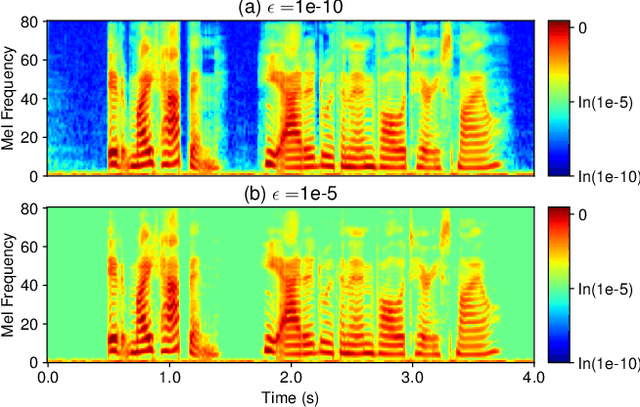
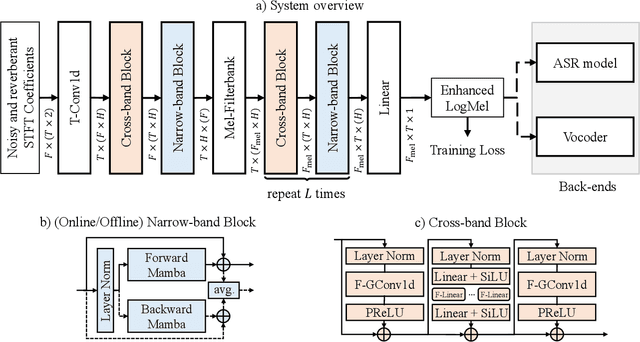
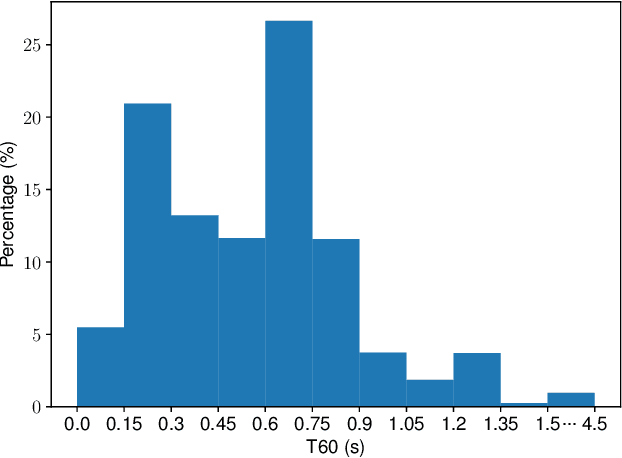
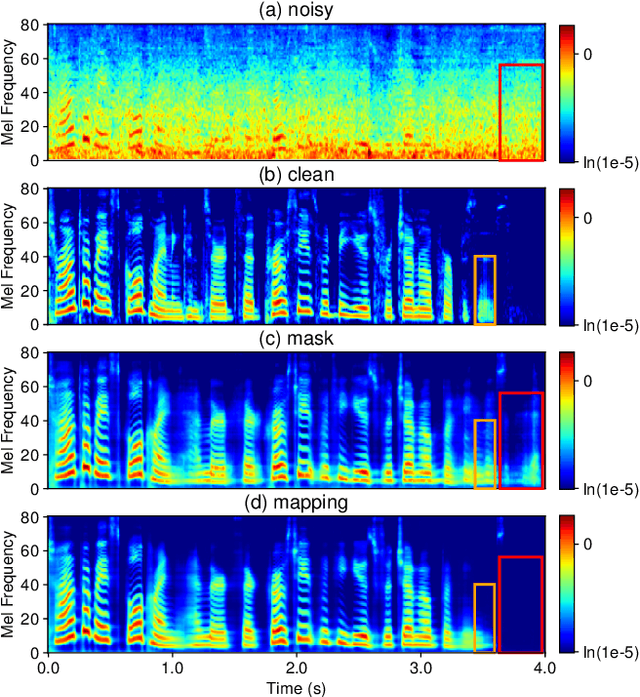
Abstract:In this work, we propose CleanMel, a single-channel Mel-spectrogram denoising and dereverberation network for improving both speech quality and automatic speech recognition (ASR) performance. The proposed network takes as input the noisy and reverberant microphone recording and predicts the corresponding clean Mel-spectrogram. The enhanced Mel-spectrogram can be either transformed to speech waveform with a neural vocoder or directly used for ASR. The proposed network is composed of interleaved cross-band and narrow-band processing in the Mel-frequency domain, for learning the full-band spectral pattern and the narrow-band properties of signals, respectively. Compared to linear-frequency domain or time-domain speech enhancement, the key advantage of Mel-spectrogram enhancement is that Mel-frequency presents speech in a more compact way and thus is easier to learn, which will benefit both speech quality and ASR. Experimental results on four English and one Chinese datasets demonstrate a significant improvement in both speech quality and ASR performance achieved by the proposed model. Code and audio examples of our model are available online in https://audio.westlake.edu.cn/Research/CleanMel.html.
Life-Code: Central Dogma Modeling with Multi-Omics Sequence Unification
Feb 11, 2025



Abstract:The interactions between DNA, RNA, and proteins are fundamental to biological processes, as illustrated by the central dogma of molecular biology. While modern biological pre-trained models have achieved great success in analyzing these macromolecules individually, their interconnected nature remains under-explored. In this paper, we follow the guidance of the central dogma to redesign both the data and model pipeline and offer a comprehensive framework, Life-Code, that spans different biological functions. As for data flow, we propose a unified pipeline to integrate multi-omics data by reverse-transcribing RNA and reverse-translating amino acids into nucleotide-based sequences. As for the model, we design a codon tokenizer and a hybrid long-sequence architecture to encode the interactions of both coding and non-coding regions with masked modeling pre-training. To model the translation and folding process with coding sequences, Life-Code learns protein structures of the corresponding amino acids by knowledge distillation from off-the-shelf protein language models. Such designs enable Life-Code to capture complex interactions within genetic sequences, providing a more comprehensive understanding of multi-omics with the central dogma. Extensive Experiments show that Life-Code achieves state-of-the-art performance on various tasks across three omics, highlighting its potential for advancing multi-omics analysis and interpretation.
Multi-scale Masked Autoencoder for Electrocardiogram Anomaly Detection
Feb 08, 2025



Abstract:Electrocardiogram (ECG) analysis is a fundamental tool for diagnosing cardiovascular conditions, yet anomaly detection in ECG signals remains challenging due to their inherent complexity and variability. We propose Multi-scale Masked Autoencoder for ECG anomaly detection (MMAE-ECG), a novel end-to-end framework that effectively captures both global and local dependencies in ECG data. Unlike state-of-the-art methods that rely on heartbeat segmentation or R-peak detection, MMAE-ECG eliminates the need for such pre-processing steps, enhancing its suitability for clinical deployment. MMAE-ECG partitions ECG signals into non-overlapping segments, with each segment assigned learnable positional embeddings. A novel multi-scale masking strategy and multi-scale attention mechanism, along with distinct positional embeddings, enable a lightweight Transformer encoder to effectively capture both local and global dependencies. The masked segments are then reconstructed using a single-layer Transformer block, with an aggregation strategy employed during inference to refine the outputs. Experimental results demonstrate that our method achieves performance comparable to state-of-the-art approaches while significantly reducing computational complexity-approximately 1/78 of the floating-point operations (FLOPs) required for inference. Ablation studies further validate the effectiveness of each component, highlighting the potential of multi-scale masked autoencoders for anomaly detection.
Star-Agents: Automatic Data Optimization with LLM Agents for Instruction Tuning
Nov 21, 2024


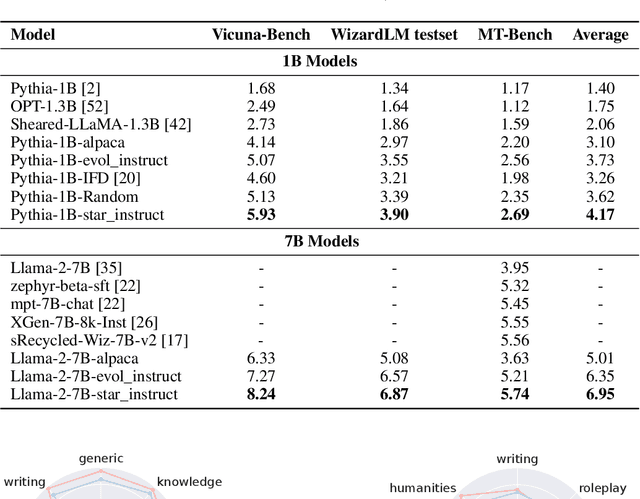
Abstract:The efficacy of large language models (LLMs) on downstream tasks usually hinges on instruction tuning, which relies critically on the quality of training data. Unfortunately, collecting high-quality and diverse data is both expensive and time-consuming. To mitigate this issue, we propose a novel Star-Agents framework, which automates the enhancement of data quality across datasets through multi-agent collaboration and assessment. The framework adopts a three-pronged strategy. It initially generates diverse instruction data with multiple LLM agents through a bespoke sampling method. Subsequently, the generated data undergo a rigorous evaluation using a dual-model method that assesses both difficulty and quality. Finaly, the above process evolves in a dynamic refinement phase, where more effective LLMs are prioritized, enhancing the overall data quality. Our empirical studies, including instruction tuning experiments with models such as Pythia and LLaMA, demonstrate the effectiveness of the proposed framework. Optimized datasets have achieved substantial improvements, with an average increase of 12% and notable gains in specific metrics, such as a 40% improvement in Fermi, as evidenced by benchmarks like MT-bench, Vicuna bench, and WizardLM testset.
Rocket Landing Control with Random Annealing Jump Start Reinforcement Learning
Jul 21, 2024



Abstract:Rocket recycling is a crucial pursuit in aerospace technology, aimed at reducing costs and environmental impact in space exploration. The primary focus centers on rocket landing control, involving the guidance of a nonlinear underactuated rocket with limited fuel in real-time. This challenging task prompts the application of reinforcement learning (RL), yet goal-oriented nature of the problem poses difficulties for standard RL algorithms due to the absence of intermediate reward signals. This paper, for the first time, significantly elevates the success rate of rocket landing control from 8% with a baseline controller to 97% on a high-fidelity rocket model using RL. Our approach, called Random Annealing Jump Start (RAJS), is tailored for real-world goal-oriented problems by leveraging prior feedback controllers as guide policy to facilitate environmental exploration and policy learning in RL. In each episode, the guide policy navigates the environment for the guide horizon, followed by the exploration policy taking charge to complete remaining steps. This jump-start strategy prunes exploration space, rendering the problem more tractable to RL algorithms. The guide horizon is sampled from a uniform distribution, with its upper bound annealing to zero based on performance metrics, mitigating distribution shift and mismatch issues in existing methods. Additional enhancements, including cascading jump start, refined reward and terminal condition, and action smoothness regulation, further improve policy performance and practical applicability. The proposed method is validated through extensive evaluation and Hardware-in-the-Loop testing, affirming the effectiveness, real-time feasibility, and smoothness of the proposed controller.
RealMAN: A Real-Recorded and Annotated Microphone Array Dataset for Dynamic Speech Enhancement and Localization
Jun 28, 2024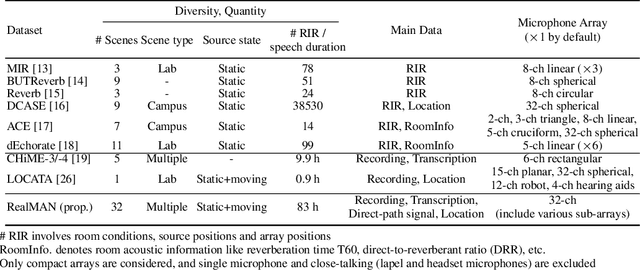
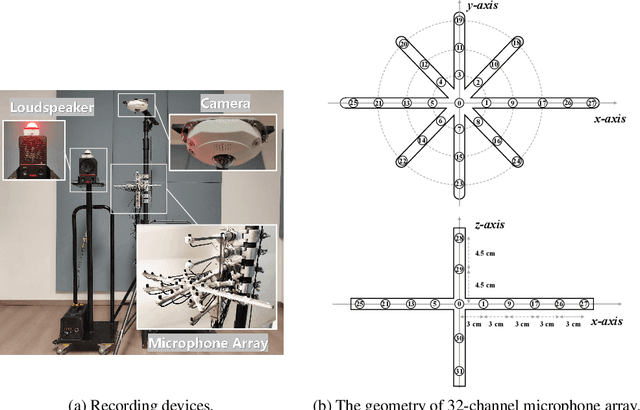


Abstract:The training of deep learning-based multichannel speech enhancement and source localization systems relies heavily on the simulation of room impulse response and multichannel diffuse noise, due to the lack of large-scale real-recorded datasets. However, the acoustic mismatch between simulated and real-world data could degrade the model performance when applying in real-world scenarios. To bridge this simulation-to-real gap, this paper presents a new relatively large-scale Real-recorded and annotated Microphone Array speech&Noise (RealMAN) dataset. The proposed dataset is valuable in two aspects: 1) benchmarking speech enhancement and localization algorithms in real scenarios; 2) offering a substantial amount of real-world training data for potentially improving the performance of real-world applications. Specifically, a 32-channel array with high-fidelity microphones is used for recording. A loudspeaker is used for playing source speech signals. A total of 83-hour speech signals (48 hours for static speaker and 35 hours for moving speaker) are recorded in 32 different scenes, and 144 hours of background noise are recorded in 31 different scenes. Both speech and noise recording scenes cover various common indoor, outdoor, semi-outdoor and transportation environments, which enables the training of general-purpose speech enhancement and source localization networks. To obtain the task-specific annotations, the azimuth angle of the loudspeaker is annotated with an omni-direction fisheye camera by automatically detecting the loudspeaker. The direct-path signal is set as the target clean speech for speech enhancement, which is obtained by filtering the source speech signal with an estimated direct-path propagation filter.
EPIDetect: Video-based convulsive seizure detection in chronic epilepsy mouse model for anti-epilepsy drug screening
May 31, 2024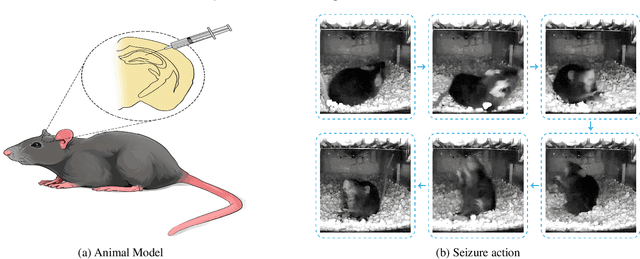
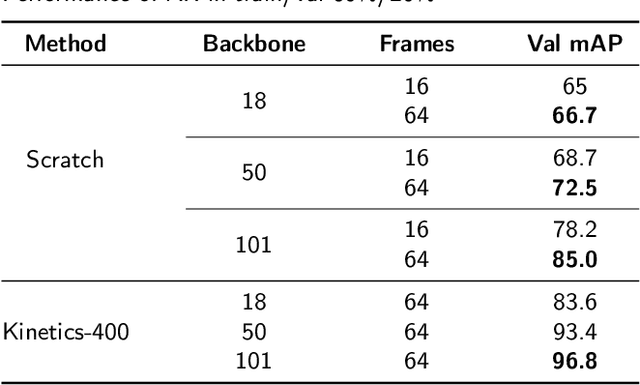

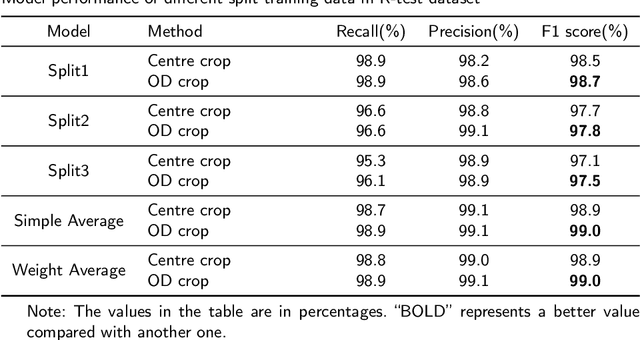
Abstract:In the preclinical translational studies, drug candidates with remarkable anti-epileptic efficacy demonstrate long-term suppression of spontaneous recurrent seizures (SRSs), particularly convulsive seizures (CSs), in mouse models of chronic epilepsy. However, the current methods for monitoring CSs have limitations in terms of invasiveness, specific laboratory settings, high cost, and complex operation, which hinder drug screening efforts. In this study, a camera-based system for automated detection of CSs in chronically epileptic mice is first established to screen potential anti-epilepsy drugs.
Policy Bifurcation in Safe Reinforcement Learning
Mar 28, 2024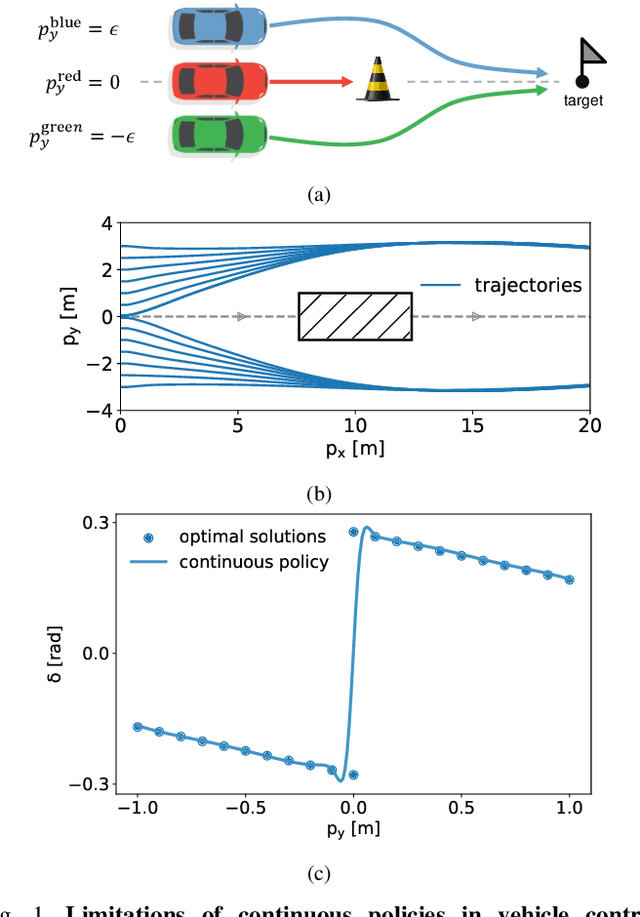
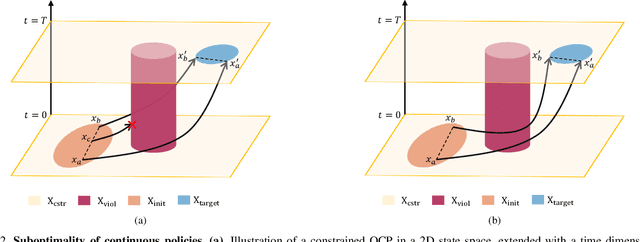
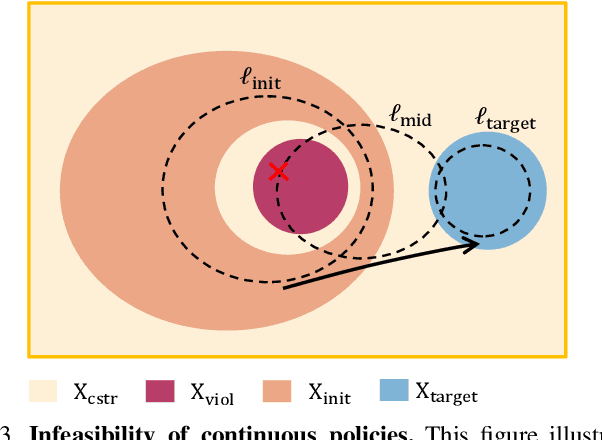
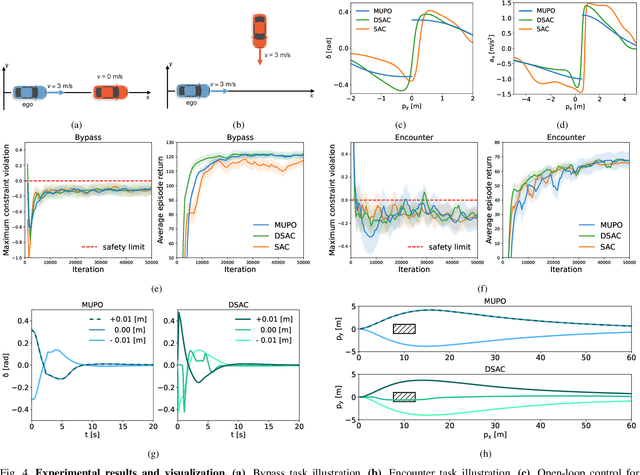
Abstract:Safe reinforcement learning (RL) offers advanced solutions to constrained optimal control problems. Existing studies in safe RL implicitly assume continuity in policy functions, where policies map states to actions in a smooth, uninterrupted manner; however, our research finds that in some scenarios, the feasible policy should be discontinuous or multi-valued, interpolating between discontinuous local optima can inevitably lead to constraint violations. We are the first to identify the generating mechanism of such a phenomenon, and employ topological analysis to rigorously prove the existence of policy bifurcation in safe RL, which corresponds to the contractibility of the reachable tuple. Our theorem reveals that in scenarios where the obstacle-free state space is non-simply connected, a feasible policy is required to be bifurcated, meaning its output action needs to change abruptly in response to the varying state. To train such a bifurcated policy, we propose a safe RL algorithm called multimodal policy optimization (MUPO), which utilizes a Gaussian mixture distribution as the policy output. The bifurcated behavior can be achieved by selecting the Gaussian component with the highest mixing coefficient. Besides, MUPO also integrates spectral normalization and forward KL divergence to enhance the policy's capability of exploring different modes. Experiments with vehicle control tasks show that our algorithm successfully learns the bifurcated policy and ensures satisfying safety, while a continuous policy suffers from inevitable constraint violations.
 Add to Chrome
Add to Chrome Add to Firefox
Add to Firefox Add to Edge
Add to Edge